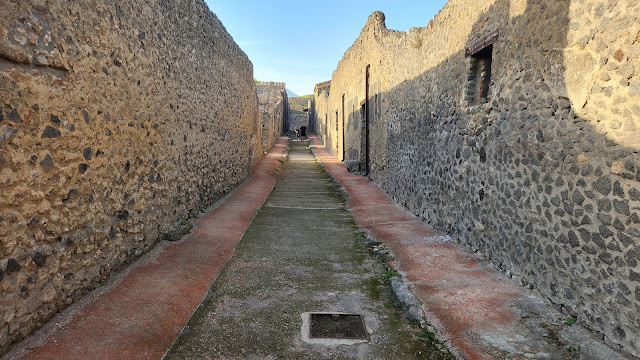 |
| Theaters of Pompeii seen from the above with a drone, with Mt. Vesuvius in the background (ElfQrin, CC BY-SA 4.0 , via Wikimedia Commons) |
Pompeii⭐⭐, famously buried by the eruption of
Mount Vesuvius in 79 AD, offers a unique glimpse into the daily lives, beliefs, and desires of its inhabitants.
Reasons why visiting Pompeii might be worth it:
- Unique historical experience: Pompeii offers a glimpse into a frozen moment in time, providing a unique opportunity to learn about ancient Roman life and culture. Walking through the ruins and seeing preserved homes, shops, and streets can be a fascinating experience.
- Well-preserved archaeological site: Pompeii is one of the most well-preserved archaeological sites in the world, offering a tangible connection to the past. You can see the intricate details of everyday life, from bakeries and bathhouses to villas and temples.
- UNESCO World Heritage Site: Recognized for its outstanding cultural value, Pompeii is a UNESCO World Heritage Site, highlighting its historical significance and global importance.
- Beautiful location: Situated near Naples and the Amalfi Coast, Pompeii offers stunning views of Mount Vesuvius and the surrounding landscapes. You can combine your visit with exploring other attractions in the area.
- Educational opportunity: Visiting Pompeii can be a valuable learning experience, especially for history buffs and anyone interested in ancient civilizations. It allows you to visualize and understand the past in a way that textbooks and documentaries cannot.
Photo Gallery
Under a warm sun on October 19th, 2023, our tour group embarked on a captivating exploration of the ancient Roman city of
Pompeii. Stepping through its gates felt like stepping back in time, as remnants of daily life stand frozen and preserved. The following photos capture some of the remarkable discoveries we made during our visit.

 |
| The Quadriporticus of the theatres in Pompeii is a large rectangular plaza surrounded by a continuous colonnade of 74 Doric grey tuff columns from Nocera. It was built in the 2nd century BC and served as a foyer for spectators attending the Large Theatre and the Odeon (Small Theatre). |
 |
| Teatro grande—This horseshoe-shaped Roman theater was preserved by the volcanic eruption of Mount Vesuvius |
Remarkable artistry: This particular domus is famous because of the exceptional artwork found in two specific rooms (rooms 8 and 12).
Room purpose: These rooms were small and meant for resting or sleeping (cubicula).
Decoration style: The paintings date from the Augustan period (approximately 27 BC – 14 AD) and belong to the third artistic style of Pompeii (Style III).
Subject matter: The paintings depict lush gardens filled with various elements:
- Plants: Palm trees, shrubs, and fruit trees such as lemon, fig, cherry, pear, plum, and pomegranate.
- Animals: Birds of different species, adding life and movement to the scene.
Overall, the detailed paintings of gardens create a peaceful and vibrant atmosphere in the bedrooms, reflecting the popular style of the Augustan era.
Since its initial construction around 200 BC, the house belonged to a
high-ranking family. From the late 1st century BC it probably belonged to the Poppeii, who were related to Poppaea, the second wife of Empreror
Nero. The atrium leads to the peristyle, onto which refined dining rooms faced; one of these features, at its center, a
vermiculatum, in the form of an elegant mosaic created with minute tesserae that depicted Pygmies on the Nile. On the western side find a small private bath complex with a colonnaded atrium. Here, in an underground corridor, a rich silver service was found wrapped in cloth, featuring 118 pieces that are today held at the
National Archaeological Museum of Naples. At the end of the portico is an altar for household worship which contained the imagines, or the portrait casts of ancestors. A narrow corridor leads to the rustic area where the reconstruction of a cart is kept.
 |
| In 1931, in the servant's quarter of the house, the remains of a small wheeled cart were discovered, known as a cisium birotus, a two-seated vehicle pulled by two mules or horses that was used for short journeys or for carrying light loads. |

































No comments:
Post a Comment
Note: Only a member of this blog may post a comment.